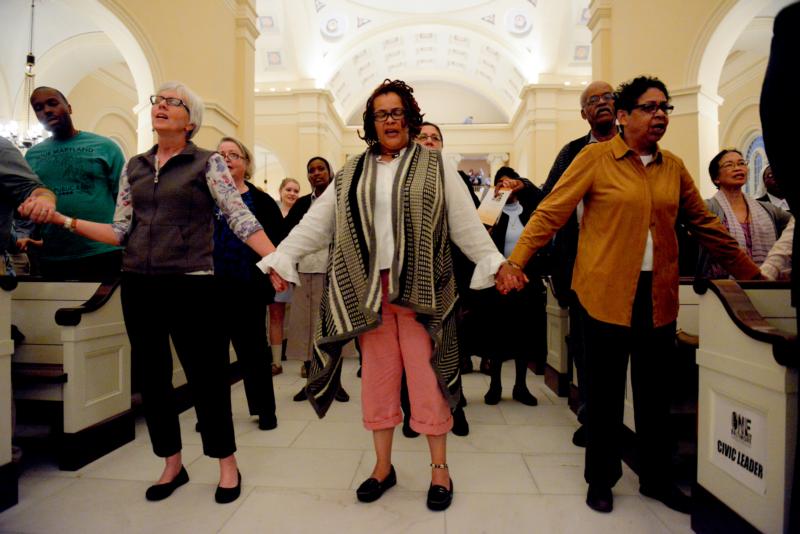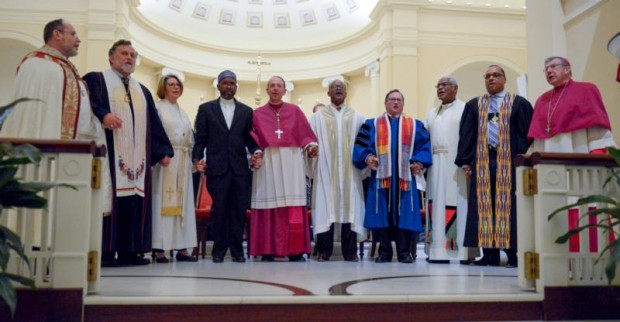BALTIMORE (CNS) — Religious leaders gathered in prayer to mark the one-year anniversary of the riots that spread through Baltimore after the death of a man injured while in police custody.
The leaders said they hear the cries of the people of the city during the interfaith service April 25 at the Basilica of the National Shrine of the Assumption of the Blessed Virgin Mary.
“We come here because we have not only heard the cries of our people, we are responding to their needs,” the Rev. Alvin C. Hathaway Sr., senior pastor of Union Baptist Church, said during the service.
[hotblock]
Rev. Hathaway said it is important that the city have a moral center. The community, he said, recognizes that much of the development in the city centers around “eds and meds” — education, schools and health care. “And that’s good. But on this day, we declare that development, true development, is done by those people who are spirit-led,” he said.
He called for citizens to renounce divisive language, bigotry and all violence in the wake of the death of Freddie Gray Jr., the man who was seriously injured while being held by police and later died, sparking protests that erupted into violence.
The prayer service included more than three dozen clergy members from the Baltimore area. Faiths represented included Catholic and other Christian churches, as well as Judaism, Islam, Hinduism and Buddhism. Baltimore Mayor Stephanie Rawlings Blake and Baltimore City State’s Attorney Marilyn Mosby were among public officials who attended as well.
The call to worship began with the blowing of the shofar by Rabbi Steven M. Fink of Temple Oheb Shalom, accompanied by Cantor Renata Braun. Imam Derrick Amin, chaplain at Morgan State University, followed with a chanted call to prayer in Arabic.

People join hands during the April 25 interfaith prayer service for peace at the Basilica of the National Shrine of the Assumption of the Blessed Virgin Mary in Baltimore. (CNS photo/Kevin J. Parks, Catholic Review)
In his welcome message, Archbishop William E. Lori of Baltimore thanked those who gathered noting, “We are united in prayer for the welfare of Baltimore. We are united in prayer for the people of Baltimore.”
He recalled walking through the streets of Sandtown-Winchester the day after the unrest. He saw a burned-out car along a deserted street, where normally there would have been the busy activity of a weekday.
“It was like an eerie scene from a movie,” he said, “the aftermath of the surreal drama that had unfolded just hours earlier, unlike anything that had been seen in our city since the 1960s.”
He celebrated Mass that weekend at St. Peter Claver Parish in West Baltimore, the archbishop said, “located just a few blocks from where that car was left as a symbol of the anger and desperation felt by many in our city. It was a joyful service, attended by many who knew that hope was indeed possible for a neighborhood and a city for which hope seemed so distant just a few days earlier. It was also marked by a profound determination for healing and change.”
After the unrest of a year ago, Archbishop Lori said faith leaders reached out to each other instinctively. “Each of us is committed to the city and has long had initiatives and programs in place — but we all knew that together we could accomplish far more and felt our unity could inspire others to realize the same.”
He said he hoped the unity of faith leaders in their commitment to be leaders of change for the city would be a model for all.
The prayer service included reflections on readings from the Passover Haggadah, the Bible and the Quran, all reflecting the theme “From Hope to Wholeness.”
Rabbi Fink said the word, “shalom,” in Hebrew, has many meanings, and its root meaning is “wholeness.”
“We pray tonight for a Shalom Baltimore, a peaceful and whole city,” he said.
Reflecting on a reading from St. Paul’s letter to the Hebrews, the Rev. Mary Gaut of the Presbytery of Baltimore, recalled watching the events of April 27 a year ago unfold “from the relative comfort of our own homes” through the mediated perspective of a TV camera.
[hotblock2]
“We got a pretty good sense of what was going on, but how great was the distance between us and what was happening there on the streets of our town?” she asked.
Events happening a few miles away felt as though they could have been as distant as hundreds or thousands of miles, she said. “Though we may have driven through these streets before, we realized we really did not know our neighbors,” she said, noting that the boundaries between those who lived in the ravaged areas and those watching on TV seemed insurmountable.
The Rev. Pat Payne, pastor of St. John Lutheran Church in Pimlico, told the Catholic Review, newspaper of the Baltimore Archdiocese, before the prayer service that the time had come for dealing with the problems of poverty, segregation and lack of opportunity. The interfaith effort becomes the conscience of such a reform.
She said it was important to participate in the event because “the challenges the city faces are the challenges of the region and the whole state. If we don’t solve them here, they will go unsolved, not just here but in the rest of the state.”
***
Gunty is CEO and associate publisher/editor of the Catholic Review, newspaper of the Archdiocese of Baltimore.
PREVIOUS: All Catholics have role in renewing marriage, family life, cardinal says
NEXT: Holder calls for slavery reparations in Georgetown talk




Share this story